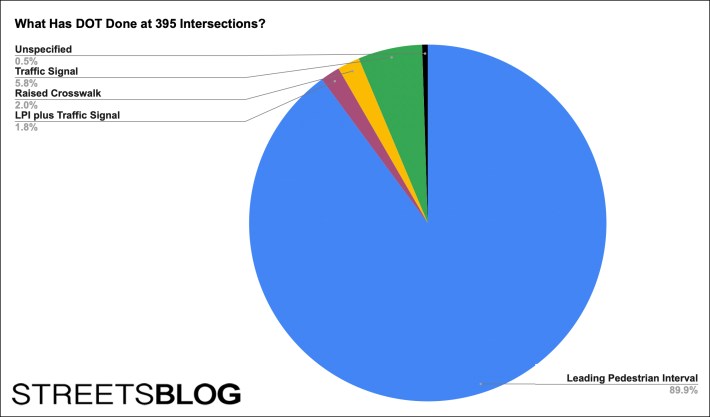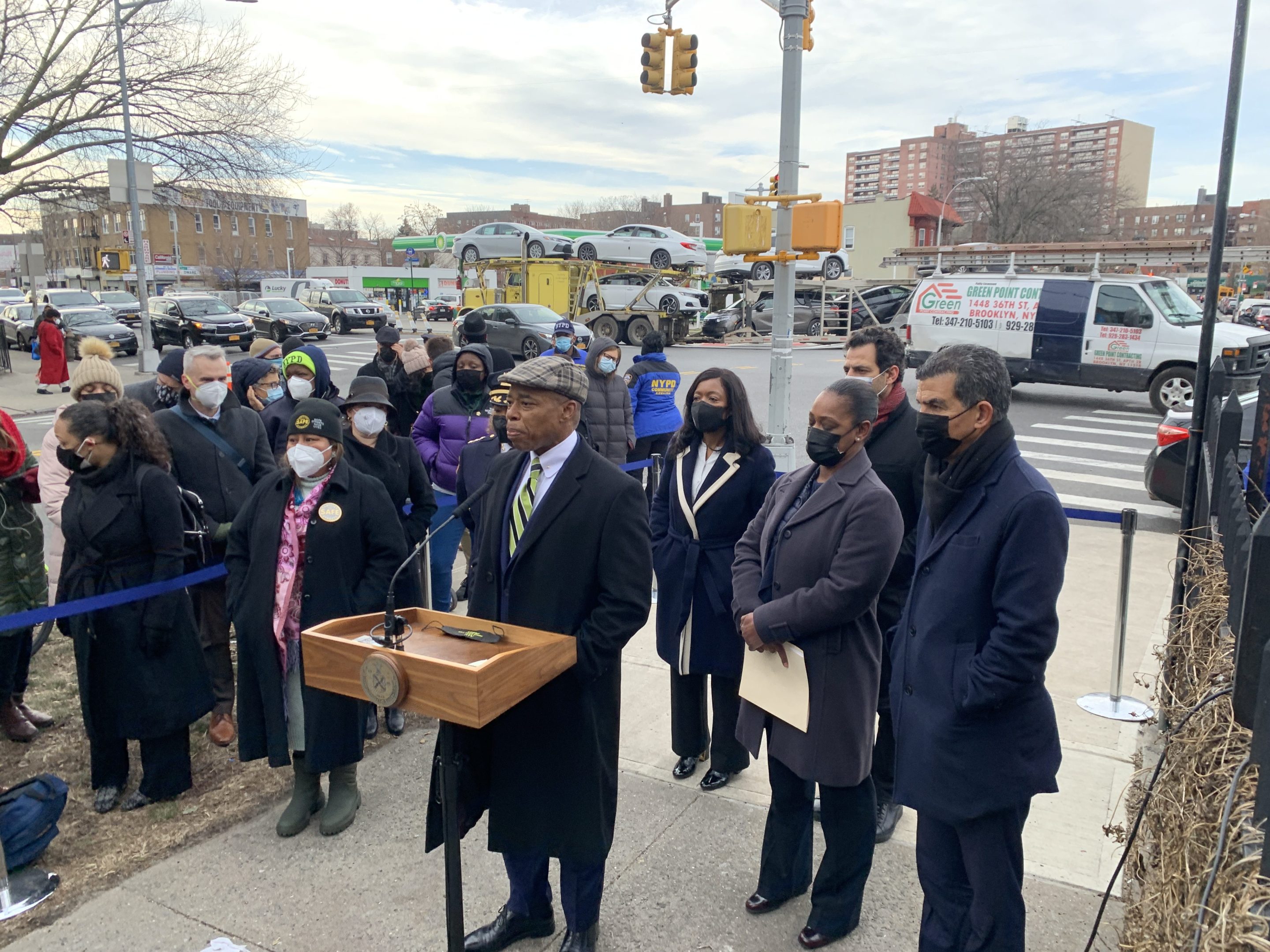Mayor Adams isn't even halfway towards reaching his promise to "make design improvements" at 1,000 intersections this year, according to the city's own publicly available data — and the pledged redesigns that have been completed have overwhelmingly been merely changing the timing of traffic lights.
According to the Department of Transportation's public databases, the city completed "improvements" at 395 intersections since Mayor Adams made his Jan. 19 announcement to "turbo-charge Vision Zero — and fast." That announcement promised that DOT would "use its full toolkit of street design treatments" at 1,000 intersections, including building 100 raised crosswalks, using bike corrals to “daylight at least 100 intersections," targeting "dozens of problem locations" where drivers can cut through parking lots or gas stations, and doubling the number of "physical elements ... to force turns at more appropriate speeds." (All quotes are from the city's press release.)
But here's what's been done at the 395 intersections, according to DOT data:
- 356 intersections (or 90 percent) have had their signal timing changed to give pedestrians a head start, a timing known as "leading pedestrian intervals" that are often referred to as LPIs.
- 23 intersections (or just under 6 percent) have gotten new traffic signals or stops signs, while seven intersections have gotten LPIs and traffic signals. (One caveat: The city's database for traffic signals merely tracks requests, so it's unclear how many of these got done or whether others got done that were not requested. The city does not have a public database of completed traffic signals or all-way stops.)
- Eight intersections (or 2 percent) have gotten raised crosswalks.
The agency has also installed 65 bike corrals this year, but geolocation coordinates in the city's database reveal that fewer than two dozen involved daylighting intersections (see map here).
The numbers not only fall short of the mayor's promise, but are even short of what DOT Commissioner Ydanis Rodriguez said had been completed when he spoke to reporters at a July 28 press conference. At that time, Rodriguez said the agency had redesigned more than half of the 1,000 intersections, but the city databases referenced above are complete through Aug. 5, yet are still below "more than half" that Rodriguez promised.
Since July, Streetsblog has repeatedly asked DOT for information regarding how many intersections have been improved, what work was done at each intersection — and, indeed, what intersections have been worked on. The mayor's original promise said that the changes would be "focused on Vision Zero priority geographies," but it appears that only three intersections — Fifth Avenue at 34th Street in Manhattan, Avenue U at E. 16th Street in Brooklyn, and Cauldwell Avenue at E, 158th Street in The Bronx — are Vision Zero priority intersections.
The agency has not provided the information beyond what is on the public databases.

The information available in the city's open data feed includes separate databases for raised crosswalks, leading pedestrian intervals, bike parking, left turn calming (which is blank), and traffic signal requests. (The city also keeps a street improvement project page, but it only had two intersections that were not in the other databases — both intersections had "unspecified" changes that are reflected in the statistics above and the map below. The city does not have a database for other safety improvements, such as pedestrian-only signal phases, sometimes known as "Barnes dances.")
What stands out the most from the above map of all the intersection modifications is how many LPIs the city made on specific corridors. Fourth Avenue in Brooklyn — where the DOT previously installed a protected bike lane — got 63 LPIs between Flatbush Avenue and 62nd Street in Sunset Park, plus another 21 LPIs between 66th and 90th streets in the area of Bay Ridge that has not gotten protected bike infrastructure.
Dangerous stretches of Fort Hamilton Parkway in Borough Park, Avenue U in Bensonhurst, Burnside Avenue in The Bronx, and East End Avenue in Manhattan also got LPIs on most blocks.
One activist was especially frustrated with the DOT's pace.
"As 55 percent of New York City pedestrians killed in crashes are hit at intersections, physical changes to intersections are key to achieving Vision Zero goals," said Liz Denys, a Brooklyn volunteer with Transportation Alternatives who helped create a master database of street changes. "Mayor Adams's 1,000 intersections promise focused on these high impact physical changes, so it's disappointing to see them at only a small fraction of the upgraded intersections."
It's worth pointing out that the total fatalities this year — 182 — are roughly the same as last year's 187, which itself was the highest of the Vision Zero era.
More telling, however, is the number of injuries from car crashes. So far this year, 35,889 people have been injured on the streets of New York, which is up 0.7 percent from the same period last year. Total pedestrian injuries are up 20 percent so far this year vs. the same period last year, with 5,543 pedestrians injured, according to the NYPD.
As such, advocates demanded action:
“The mayor pledged to make expedient and substantive changes to dangerous intersections — and we’ll need nothing less to combat the escalating danger on our streets,” said Sara Lind, director of policy at Open Plans. “But so far, this pace simply does not match the urgency of the issue. We need all hands on deck. The city must allocate the resources needed for DOT to employ their full toolkit of redesign tools. And local opposition cannot delay the process — we need Council members and community boards throughout the city to actively identify dangerous intersections and help DOT get them fixed.”
Open Plans is a sister organization of Streetsblog.






